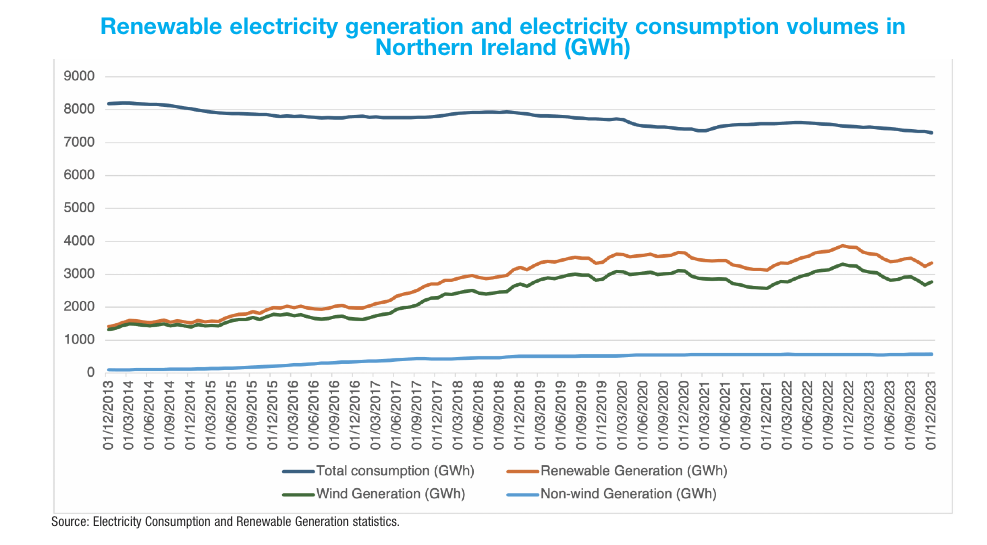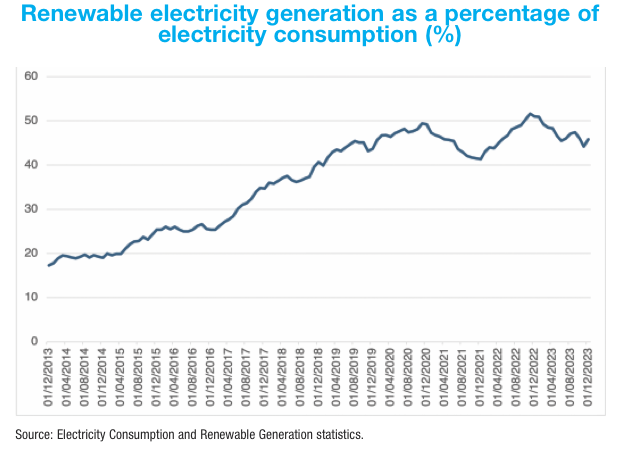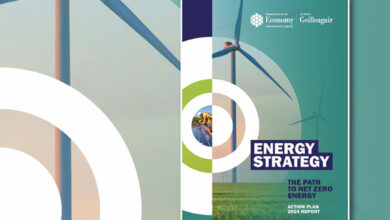Action needed to address renewable electricity 2030 target gap

A 5 per cent annual decrease in the consumption of renewable electricity in Northern Ireland has highlighted the need for the acceleration of offshore wind generation and grid storage if an ambitious 80 per cent target for 2030 is to be met.
Northern Ireland saw a decline in indigenous renewable electricity consumption in relation to total electricity consumed over the 12 month period, despite the 80 per cent 2030 target for renewable energy consumption.
Within the rolling 12 month average in 2023, 45.8 per cent of total electricity consumption in Northern Ireland was generated from renewable sources located in Northern Ireland.
The 2023 total renewable electricity consumption represents a decrease of 5.3 percentage points on the previous 12 month period (year ending December 2022).
Therefore, in order to meet targets outlined by the Climate Change Act and Path to Net Zero strategy, significant measures need to be taken to ensure that renewable energy consumption continues to increase consistently.
Northern Ireland, once a leader in renewable generation, has stagnated over the past decade, highlighted by the fact that only 86MW of new large scale generation has been connected in that time.
The Department for the Economy is expected to deliver a new Renewable Electricity Support Scheme, aimed at increasing levels of renewable generation, in 2024, while simultaneously producing an offshore renewable energy action plan.
However, critical to meeting the target of 80 per cent renewable electricity consumption by 2030 will not just be increased generation, but also the electricity grid’s ability to store and balance renewables. Despite the annual decrease in renewable consumption, the report found that of all renewable electricity generated within Northern Ireland in the year ending December 2023, 82.9 per cent is generated from wind. This compares to 85.3 per cent for the previous 12 month period, suggesting that there has been an increase in other sources for renewable generation.
The second largest renewable energy source in Northern Ireland is generated through biogas (6.6 per cent), followed by biomass generation (4.7 per cent), solar PV (3.7 per cent), landfill gas (1.5 per cent), and other (0.7 per cent).
For the year ending December 2023, non-wind renewable electricity generation in Northern Ireland was 571 GWh (17.1 per cent).
Furthermore, in December 2023 specifically, 59.5 per cent of total electricity consumption in Northern Ireland was generated from renewable sources located in Northern Ireland.
Annual volume generated and consumed
In terms of the volume of electricity consumption in the year ending December 2023, some 7,297 Gigawatt hours (GWh) of total electricity was consumed. Within the decade, total electricity consumption in Northern Ireland has fallen by 10.8 per cent.
Additionally, some 3,341 GWh was generated from renewable sources located in Northern Ireland. This equates to an increase of 135.4 per cent over the 10 year period.
The Climate Change Act (Northern Ireland) 2022 outlines that “at least 80 per cent of electricity consumption” must be generated from renewable sources by 2030.
Furthermore, the Path to Net Zero Energy strategy aims to continue to drive short-term progress towards the ultimate goal of a decarbonised energy system in relation to all Northern Ireland’s heat, power, and transport needs.
Meeting long-term targets
Despite the variation of renewable electricity generation month-to-month, the average of indigenous renewable electricity generation has been on a general decline since November 2022.
Therefore, irrespective of renewable electricity generation and electricity consumption volumes in Northern Ireland continuing on a general increase over the decade, there is still significant work to be done to continue to increase energy consumption on an annual basis, and thus meet its target of nearly double its current renewable electricity generation.
The next Electricity Consumption and Renewable Generation in Northern Ireland publication will be issued in June 2024.







